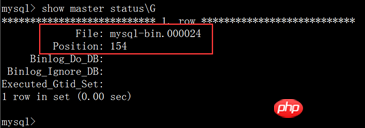Home >Database >Mysql Tutorial >Detailed example of MYSQL dual-master full database synchronous replication
Environment:
The two servers A and B are installed with the mysql-5.7.18 server respectively and configured to synchronize each other's master and slave.
The linux system version is CentOS7
A server ip: 192.168.1.7 Host name: test1
B server ip: 192.168.1.8 Host name: test2
(Under the same LAN)
1. Preparation
1. Modify the host name
Command: hostnamectl set-hostname xxx
(View host name command :hostname)
2. Turn off the firewall
1) Check the firewall status
Command: firewall-cmd --state
Result: running
2) The firewall is running. First, shut down the firewall service. ## 4) Check the firewall status
Command: firewall-cmd --state
Result: not running
3. Turn off selinux policy
1) Check selinux running status
Command: getenforce
Result: Enforcing
2) Permanently shut down (need to restart the computer), edit selinux File vi /etc/sysconfig/selinux modify SELINUX=disabled
3) To the closed state
2. Configuration Master server (master) slave server (slave) 
log-bin=mysql-bin log-bin-index=mysql-bin
 [In the B server my.cnf file mysqld], add the content in the above picture, and only change the server-id value.
[In the B server my.cnf file mysqld], add the content in the above picture, and only change the server-id value. server-id=2 log-bin=mysql-bin log-bin-index=mysql-bin2. Create the full library backup file all.sql in the mysql installation path in server A (the rpm installation path is /var/lib/mysql). Create command:
touch /var/lib/mysql/all.sql
 Backup command:
Backup command: [root@test1 mysql]# mysqldump -uroot -p123 --all-databases > /var/lib/mysql/all.sql
Copy the all.sql file to a path in server B (use the /var/lib/mysql path (for example) to restore.
Restore command:
[root@test2 /]# mysql -uroot -p123 < /var/lib/mysql/all.sql
3. Create users in mysql of servers A and B for synchronization.
Create user:
mysql> create user 'tongbu'@'%' identified by 'tongbu';
Authorization:
mysql> grant all on *.* to 'tongbu'@'%';
Delete user:
mysql> drop user '用户名'@'%';
After the A and B server users are created, test whether the users can remotely access each other Log in to mysql.
[root@test1 /]# mysql -utongbu -ptongbu -h192.168.1.8 [root@test2 /]# mysql -utongbu -ptongbu -h192.168.1.7
Restart the mysql service in servers A and B after testing without problems: [root@test /]# service mysqld restart
4. Set A as the master server and B as the slave server.
1) View the binary log name and offset value in server A mysql
Command: mysql> show master status\G
As shown below
## 2) Configure the connection server in server B
mysql> stop slave; mysql> change master to -> master_host='192.168.1.7', -> master_user='tongbu', -> master_password='tongbu', -> master_log_file='mysql-bin.000024', -> master_log_pos=154; mysql> start slave;
mysql> show slave status\G Enter this command to check whether the values of Slave_IO_Running and Slave_SQL_Running are Yes, as shown below
 5. Set B as the master server and A as the slave server.
5. Set B as the master server and A as the slave server.
1) View the binary log name and offset in server B mysql
Command: mysql> show master status\G

2 ) Configure the connection server in server A.
mysql> stop slave; mysql> change master to -> master_host='192.168.1.8', -> master_user='tongbu', -> master_password='tongbu', -> master_log_file='mysql-bin.000027', -> master_log_pos=154; mysql> start slave; mysql> show slave status\G 查看Slave_IO_Running和Slave_SQL_Running的值是否为Yes
At this point, the master-slave synchronization configuration of the two mysql databases is completed.
Error troubleshooting:
主键冲突、表已存在等错误代码如1062,1032,1060等,可以在mysql配置文件指定略过此类异常并继续下条sql同步,这样可以避免很多主从同步的异常中断。打开/etc/ mysql下的my.cnf文件,在[mysqld]后添加如下代码:
slave-skip-errors = 1062,1032,1060
3. 跳过异常恢复同步
mysql >slave stop; mysql >SET GLOBAL sql_slave_skip_counter = 1; mysql >slave start;
The above is the detailed content of Detailed example of MYSQL dual-master full database synchronous replication. For more information, please follow other related articles on the PHP Chinese website!